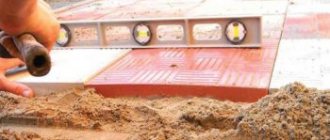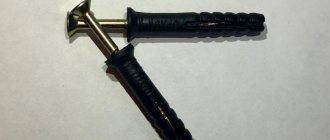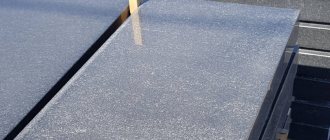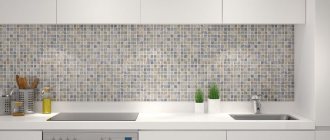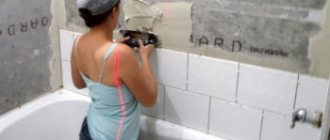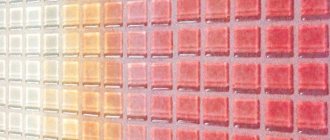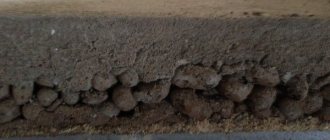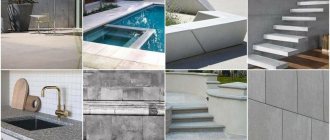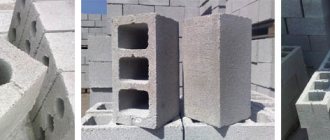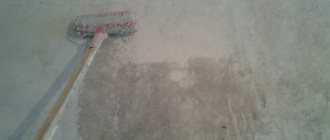What are the rules for choosing tile adhesive?
When selecting adhesive for ceramic tiles or tiles in the bathroom or kitchen, you need to take into account some criteria that will help you choose a good suitable adhesive composition. It is worth highlighting the following most important criteria:
- Type of rough surface. Laying tiles can be done on different surfaces: tiles, plasterboard, concrete, plastered, etc.
- Dimensions of one tile, general dimensions of the surface being treated. If the tile products are large, then the adhesive should be chosen with high adhesion, because The finishing material weighs a lot and will create a strong load.
- Place of work. For bathrooms and bathrooms, it is necessary to choose a waterproof adhesive that can withstand the constant influence of high levels of humidity. If the tiling is done in the hallway, corridor, or kitchen, then you can simply choose a good adhesive for installing tiles that does not have high moisture-resistant properties.
- Installation method. If you will be laying the tiles yourself, then it is recommended to buy adhesive mixtures that will not dry quickly, giving the installer the opportunity to correct any imperfections in the finish. When carrying out work by professionals, you can choose high-quality quick-drying mixtures.
Important! It is not recommended to use universal glue and mixtures designed to work with different materials. It is recommended to select a specialized waterproof adhesive for floor tiles. These types of adhesives for floor tiles will last much longer than their universal counterparts, and will also be able to provide better fastening of products to the floor and wall surfaces.
Criterias of choice
Sellers or advertising are unreliable advisers on the question of which ceramic tile adhesive to buy. Experienced craftsmen can recommend a manufacturer, but in order to choose the best option, the following factors should be clarified:
- The material of the surface on which the installation is made. If you have to work with concrete, it is better to choose a cement mortar, if with plasterboard - dispersion;
- Type of tile. The density, absorbency, and weight of the tiles affect the selection of adhesive. Heavy, dense finishing requires special qualities from it - increased adsorption, plasticity;
- Installation location. Compositions for laying on floors and walls differ. For floors, professional finishers often use cement mortar, which can be used to make the floor “level” without preliminary work;
- Color. Which color to choose is decided depending on the shade and type of tile. For regular tiles, gray glue is used, and for transparent mosaics, white glue is used;
- Tile size. The larger the size (30*30 cm or 30*50 cm), the better adsorption the glue should have ;
- Special requirements. Manufacturers add antiseptic or fungicidal drugs to some adhesives that fight mold. Of course, the additional capabilities of the glue increase the price, but justify the cost.
Various adhesives
Worth noticing! An important factor in choosing glue is the consumption during installation, for finishing 1 square meter. m of surface of average uniformity spend 5 kg, you must agree, having calculated the area of the walls and floor, the cost of its acquisition will become a serious item in the budget for repairs.
Types of tile adhesive
If we talk about what kind of adhesive you can choose for tiles, ceramic products, tiles, it is worth highlighting several types of mixtures. To carry out these works, cement, dispersion, elastic, epoxy mortars are usually used.
Cement
The basis of such adhesives for floors or walls in the kitchen, bathroom, and hallway is ordinary cement. Such products are inexpensive and sold in powder form. Therefore, the dry mixture must be mixed with water before use.
When choosing a cement composition, you need to look at the packaging, which should be marked: “tile adhesive.” The mixture can be thin-layer (for perfectly level surfaces) or thick-layer (for uneven surfaces).
Dispersive
When choosing a dispersion adhesive for floor tiles, you can count on a high level of adhesion of finishing materials. The composition is represented by a mixture of acrylic materials with binders and synthetic resin substances.
Therefore, it is best to choose it for plasterboard, varnished, painted surfaces, for walls and floors with old finishes that cannot be removed. The dispersion type of adhesive is not suitable for concrete coatings.
Important advantages of dispersion mixtures include:
- Cleanliness and order when carrying out finishing work (when compared with cement analogues).
- There is no need to prepare ready-made moisture-resistant adhesive for tiles in the kitchen or on the bathroom floor with your own hands.
- Hardening takes quite a long time, so it is possible to adjust the location of the tiles after applying the adhesive.
Elastic
Elastic types of adhesives for laying tiles and ceramics are suitable for interior work and for surfaces that lack moisture absorption characteristics, for moving structures. Elastic compounds are an excellent solution for covering floor coverings with “warm floors”, because the applied adhesive solution will be resistant to thermal expansion and contraction.
Epoxy
You should not give preference to epoxy adhesive for tiles in the bathroom or kitchen, because... Such compositions are not chosen for residential premises. Epoxy mixtures are much more expensive than previous analogues. It is also difficult to work with them without the proper skills and experience. For example, during the process of laying epoxy tile adhesive, it is necessary to observe strict temperature conditions, and when mixing the mixture, strictly monitor the proportions.
Epoxy compounds are used to carry out work in:
- Saunas.
- Swimming pools.
- Baths.
- Utility premises.
When using epoxy glue, dampness in wet areas is not important because it is 100% waterproof. Using it, it is possible to lay tile materials on different types of surfaces.
Consistency
It is difficult to say which adhesive for bathroom tiles will be better, because in some cases the adhesive composition must be selected individually, taking into account the conditions of work and operation of the material. Compositions sold in stores may have different consistencies:
- Liquid. Mixtures in the form of a paste that are ready for use immediately after opening the package - the consumer does not need to knead or mix anything. Convenient for all those who want ready-made adhesive for bathroom tiles. The main disadvantage of such products is the high price (when compared with dry formulations). Separately, Fr. These types of glue cannot be used for laying ceramic tiles in the bathroom - only for repairing and restoring individual finishing elements.
- Dry. Traditional dry mixes must be mixed before use in accordance with the instructions on the package. Such products are inexpensive and suitable for laying tiles on uneven and poorly leveled surfaces.
Special properties
Tile types of adhesives for bathrooms have different characteristics; they glue tiles in different ways, so when choosing them, it is necessary to take into account the presence of special properties. Most often you can see the following characteristics of adhesive mixtures:
- Quick drying. Such compositions, as the name implies, dry fairly quickly - the laid material can be used within 2-3 hours after completion of the work. This tile adhesive is waterproof and frost-resistant, but can only be used for finishing work on simple, flat, stationary surfaces. Quick-drying compositions are presented in the form of dry mixtures. You should pay attention to the following brands: Ivsil Express, Knauf Schnell Kleber.
- Frost-resistant. This type of tile adhesive for bathrooms and kitchens is sold in the form of a dry composition, so it is easy to store and transport. 100% retains its working properties at low positive and negative temperatures. Suitable for use in country houses and summer cottages. The most popular brands include: Ceresit Bautechnik, Kreisel MULTI 102, Knauf HP Start.
- Heat resistant. An excellent adhesive option for bathroom tiles, as well as for finishing surfaces that will heat up during operation (warm floors, fireplaces, stoves, etc.). The applied composition is able to withstand high operating temperatures - up to 110-120o C. At the top of the rating of heat-resistant tile adhesive are the following brands: Webervetonit RF, Ceresit CM 17, IVSIL EXPRESS, FEROZIT-108.
- Acid resistant. Not everyone knows how to choose an adhesive for laying tiles that will be used in an aggressive environment. In this case, preference should be given to acid-resistant adhesive compositions, which are used if the material will be exposed to various chemicals.
- Water resistant. A tile adhesive is called waterproof if it is waterproof and inert to liquids. Such adhesive compositions are the best option for finishing work in bathrooms, toilets, kitchens, hallways, as well as in any other rooms and places where tile products are exposed to high humidity and liquid. Trademarks that deserve special attention are: Ceresit CM 17, Pobedit Pool TM-16. If we talk about which tile adhesive will be better for the bathroom, then it is worth highlighting waterproof compounds. Their only drawback is their high price (when compared with conventional liquid and dry mixtures for laying tiles and ceramics).
- Universal. Choosing a universal adhesive for bathroom tiles is a rather controversial decision. This is a ready-made adhesive for bathroom tiles, which has very limited characteristics. For example, it cannot be used in rooms with high humidity, porcelain stoneware products cannot be laid on it, and it cannot be used if the room has heated floors. Universal glue is selected if it is intended to be used under average operating conditions.
Types of bases
The choice of tile adhesive largely depends on the base on which the elements will be laid. Most work is carried out on a concrete surface; in this case, mixtures containing sand, cement and additives are useful.
The purpose of the room and factors that may negatively affect the tiles and adhesive composition should be taken into account. If liquid constantly accumulates in the room, then it is better to take moisture-resistant compounds. If the tiles are mounted on a wall, then you cannot use compounds with high spreadability, but for the floor they are an ideal solution.
When laying tiles on drywall, it must be taken into account that it is covered with paper, so in this case it is best to choose a composition that has water-repellent properties. It is necessary to take into account that if you install the tile directly on drywall, then if it is necessary to dismantle it, it will not be possible to do this without damaging the surface. If you plan to dismantle the cladding in the future, you must first plaster the base, and only then lay the tiles.
Often there is a need to install tiles on chipboard or OSB boards, wood or plywood. When choosing the best glue in this case, you must take into account the fact that wooden surfaces will change their volume depending on temperature and humidity, and such changes in size can lead to damage to the cladding over time.
There are special compounds that are designed for wooden surfaces. Their feature is high elasticity, so even in the presence of dynamic changes in the base, the cladding remains unharmed.
How to calculate glue consumption?
In the store you can find different shades of tile adhesive: white, gray, transparent, dark, etc. Color does not affect the consumption of the adhesive composition in any way. To find out the approximate consumption of the mixture, you need to inspect the packaging, although the manufacturer’s instructions give very average figures.
The total consumption of finished adhesive for bathroom tiles is influenced by the following factors:
- A type of adhesive composition. Different types of glue have different consumption. For example, cement compositions that must be diluted with water are consumed in quantities of 1.4 to 2 kg per m2. For epoxy mixtures, the consumption is much lower, while for dispersion mixtures it is usually higher.
- Features of laid tiles. If you glue porcelain tiles, the glue consumption will be minimal. When working with glazed products, it will increase, and when using handmade tiles it will be maximum. Therefore, packs and packages with glue for porcelain tiles are usually smaller in size and volume.
- Type of surface to be finished. If the surface is perfectly flat, then the glued tile will be held in place with a minimum amount of glue. If there are defects and irregularities on the surface that need to be hidden, then the consumption of the adhesive composition can increase 2-3 times.
- Temperature conditions. When finishing work is carried out in optimal temperature conditions (from +15 to +23 degrees), the consumption of tile adhesive composition will be minimal. At high temperatures, moisture will rapidly evaporate from the prepared solution, so the consumption will increase proportionally.
- Work technology and layer skills. If finishing work is carried out by professionals, then the consumption will be insignificant - within normal limits. If you do the work yourself, the cost will increase.
Popular manufacturers
There are different tile adhesive manufacturers on the market. In this case, we can highlight several of the most popular brands.
"Eunice"
One of Knauf's main competitors. “Yunis” adhesive mixtures have high adhesive parameters, quick drying after application, frost resistance, and resistance to 100% indoor humidity. They can be used to finish heated and cooled surfaces. Approximate consumption is from 3 to 4.5 kg/m2. Cost – up to 300 rubles per package.
"Mastplix"
An ideal option for a tile adhesive composition if the surface to be finished is not even. Mastiplax adhesive is recommended to be used if there are uneven surfaces that need to be eliminated and the tiles can be laid successfully. Mastiplax mixtures are suitable for laying ceramics, porcelain stoneware, artificial and natural stone. Cost - about 280-290 rubles per package.
Ceresit
One of the most famous manufacturers of various adhesive compositions in the CIS. The company sells the mixture for laying tiles at a price of no more than 250 rubles per package, so it can be considered inexpensive. Ceresi is suitable for working with uneven surfaces. After application, the compositions will quickly set, preventing the tile products from slipping. Can be used without restrictions in domestic and residential premises.
Knauf
Adhesive compositions for tile materials from the Knauf company are considered one of the best on the market. One package of such a product will cost 250-270 rubles. These are German quality products, which are used for installing tiles on walls and floors (regardless of the structure and type of surface). The mixture dries slowly, so work can be done slowly. Knauf compositions are characterized by increased strength, water resistance, and elasticity.
Ivsil Mosaik
Quite an expensive adhesive for tiles. This is a tile adhesive with a pronounced white color, which has high adhesion strength to the surface. It can be used indoors and outdoors. Suitable for fastening tile materials and natural stone. Can be used for finishing work in any wet areas (swimming pools, baths, saunas, bathrooms, etc.). Cost - about 400-500 rubles per package.
It is also worth paying attention to the brands Litoflex, Bergauf Mosaik, Mira Super Fix, Sopro, Keraflex Maxi. Considering the variety of products, it is difficult to say which tile adhesive is better. But experts note the brands Knauf, Ceresit and Unis.
Tile adhesive (2 videos)
Types of tile adhesive (17 photos)
Ceramic tiles are the most suitable option for finishing the bathroom and toilet. The beauty and durability of the coating put tiles in first place compared to other finishing materials. Tiles are used to decorate the wall above the work area in the kitchen and are used as flooring in the kitchen and hallway.
In the hallway, tiles go well with laminate. The part of the floor that bears the greatest load is tiled, the rest is covered with laminate. It turns out practical and cozy.
A combination of tiles and laminate would also be appropriate in the kitchen.
In order for the ceramic tile coating to serve you for a long time, you need to properly prepare the surface for laying the tiles and, most importantly, choose high-quality tile adhesive.
Adhesive for laying ceramic tiles
Dry mixtures are produced based on cement. This mixture is diluted with water. Mixtures from different manufacturers differ in elasticity. Yunis and Ceresit have proven themselves well; don’t be afraid to use glue - at a fairly low price, it has good qualities. If the surface is flat, the tiles are laid “under the comb” - using base glue. To lay large tiles and porcelain stoneware, you will need reinforced adhesive. Small tiles and mosaics are laid with white glue.
It is difficult to determine which glue is considered the best. Every craftsman will praise you about the glue he is used to working with.
The “Mask” glue has good reviews. Available with different markings - for heavy tiles, porcelain stoneware, for interior and exterior decoration. Super white is available for mosaics and can also be used for grouting.
Among the dry mixtures you can find glue with the addition of plasticizers. The plasticizer slows down the setting of the glue and gives elasticity to the solution. This glue is convenient to use for those who have little experience.
Dispersion adhesive is well suited for facing drywall. The glue is ready for use. The price is more expensive than cement mixtures. The advantage of this glue is its elasticity.
The adhesive must be suitable for the surface on which the tiles are laid. When tiling the façade of a building, adhesive for exterior use is used. There is a special glue for baths and saunas, as well as for surfaces exposed to high temperatures - fireplaces and stoves.
How to calculate tile adhesive consumption
Glue consumption is calculated for the prepared surface. It should be flat, the corners should be straight, the walls should be strictly vertical. To level the walls, plaster is used, the floor is leveled using a screed. Only an experienced tiler can level the surface while working using tile adhesive, so take the time to prepare the base.
Having smooth walls, it is not difficult to calculate the consumption of tile adhesive. The adhesive is applied to the tiles with a notched trowel. The size of the spatula depends on the size of the tile. The table will help you choose the right spatula and calculate how much glue is needed per square meter.
The price of glue depends on its category and, accordingly, quality. On the packaging you will find the inscription “economy”, “standard”, “premium”, “luxury”. The “premium” category is higher in price, but if the apartment is in a new building, which means the house will be subject to shrinkage, it is better to take the “premium” one. Glue of the “standard” category has an acceptable price category and has good qualities. Ready-to-use glue is always more expensive. Pay attention to the glue consumption per square meter indicated on the packaging. At the same cost, glue consumption may vary significantly.
How to calculate tile consumption
When choosing tiles, consult a designer. Ask them to create a computer layout of the tiles for you and calculate how many of which tiles you need to take. Having this layout makes it easier to lay the tiles, and you will immediately have an idea of how it will all look. Crosses are suitable for 1.5 mm, for floor tiles 2-2.5 mm.
When laying tiles diagonally, its consumption increases. Take the tiles with a small margin - there is always a possibility of the tiles splitting and damaging during transportation and during work. It can be difficult to purchase additional tiles from the same batch.
How to glue ceramic tiles with your own hands
To glue the tiles you will need
• brush or roller for priming
• notched and regular spatula 10 cm wide
• container for mixing glue
• level
• drill
• drill attachments - mixer and bits for drilling round holes
• tile cutter
• Bulgarian
• rubber spatula for grouting joints
After leveling and drying the plaster and floor screed, prime the surface. Apply contact concrete to the drywall. While the primer is drying, install the guide. It is better to use a metal profile for the guide. You can also use a wooden strip if it does not have any curvature.
Laying tiles begins from the second row from the floor. Starting the marking from the ceiling, calculate how many tiles will fit in a vertical row, add distances for the seams. Make a mark along the bottom edge of the penultimate tile from the floor. It is at this level that you need to secure the guide. The guide is set using a level. If you have a laser level, good. But this is too expensive a tool for home use. The most reliable thing is the hydraulic level. Make marks along the entire perimeter so that the horizontal seams of the tiles match at the corners. It remains to fix the metal profile, which will serve as a guide.
If you want to lay tiles from the bathroom without reaching the floor, calculate the first row of tiles based on the height of the bathroom.
When laying out panels, it is better to lay out the tiles on the floor and then lay them in a certain sequence.
It is better to start marking the floor from the door; after markings are applied, the tiles begin to be laid from the corner.
When all preparations are completed, you can mix the glue and begin laying the tiles. The adhesive is applied to the tile or surface with a notched trowel.
Using a level, make sure that the tiles are in the same plane and that the corners of adjacent tiles match.
To ensure that the seams between the tiles are even, special crosses are used.
The tiles are cut using a tile cutter.
If you need to cut a corner of a tile, take a grinder, or use a tile cutter with a diamond wheel.
A regular tile cutter will not cut porcelain tiles. It is also better to cut it with a grinder. When working with an angle grinder, be careful - wear safety glasses.
To make the angle straight, use a metal square for marking.
The hardest part is cutting the tiles for the outside corner. The edge of the tile is cut with a grinder at an angle of 45 degrees.
Cutting corners in this way is a very difficult job, so it is easier to insert special plastic corners that are available for external and internal corners.
The holes for the pipes are cut with a crown using a drill.
Don't forget to include decorative elements.
In bathrooms, start with the walls, then tile the floor.
After the tiles are laid and the glue has dried, you need to grout the seams. Crosses and excess glue are removed with a spatula or a regular screwdriver, the seams are cleaned, and then filled with ceramic tile grout using a rubber spatula. Immediately wipe the tiles with a damp sponge to remove excess. Do not allow the grout to dry out, and do not use sandpaper to remove it - you can damage the enamel.
If the tiles are laid according to all the rules, the results of your work will please you.
You can watch a visual lesson on laying tiles in the video.
